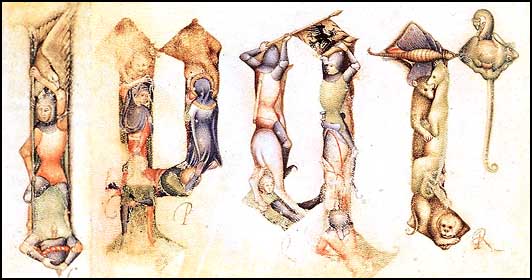Your Legal Resource
Art As Letterform (part 1)
Art as Letterform (Part 1)
by Mark Filipas
We have now looked at several illustrations linking a subject to its initial letter. Here we find examples of art as an alphabetic letterform. In several cases, not only does the designer form letters from the figures themselves, but his figures also make their own linguistic allusions.
- Jeremiah forms the letter �J�, from a prologue to The Book of Haggai, 13th-century France.
- The initial �V� for verbum is formed by two interlocking figures. This example is from The Book of Zephaniah in a 13th-century French Bible.
- A 12th-century copy of Josephus� Antiquity of the Jews uses the figurative letter �P�.
- The initial letter �I� for In Anno, introducing The Book of Ezra in the c.1109 Bible of Coteau. The letter is formed by a scribe holding a scroll.
- The 8th-century Sacramentary of Gellone includes this initial �E� for ecclesia.
Often, figurative letters were mere decoration, with no linguistic allusions at all. Such instances sometimes took so many artistic liberties that their letterforms are barely recognizable, as we can see with several examples on this page.
- The letter �H� shown above is from an 8th-century Brussels work titled Etymologies.
- A round initial �E� (shown above) from an 8th-century Parisian Sacramentary.
- A capital �E� (shown above) from the same Parisian Sacramentary.
- In 1683, Giuseppe Mitelli designed the figurative Roman letters known as the Dream Alphabet. Each design was not only an allegorical figure posing as a letter, but the Italian names of the pictorial subjects began with their corresponding letter.
His letter �D� (shown above) depicts Diligenza or Diligence, showing a man bracing his feet against a pillar and trying to topple it toward himself; above this is a Delfino digrignamento, or dolphin baring his teeth. His letter �F� (shown above) is Fortuna or Fortune, a maiden whose hands and basket of fruit form the shape of the letter; above her is a smaller image of a fenice or phoenix.
- Consisting of tightly interwoven human and animal figures, The 24 letters of the Bergamo Alphabet were designed by Giovannino de Grassi c. 1390. An accomplished Italian artist at the Visconti court, de Grassi also illustrated much of The Visconti Book of Hours, whose illuminations contain several linguistic allusions as well as figurative letterforms.
- The alphabet of Giovannino de Grassi was part of his �model book�, sketch references to be copied by the students of a master�s studio. Di Grassi�s influence can be seen in the letter designs of the German Master E.S.
- Peter Fl�tner of Germany designed this alphabet using the human figure, c. 1534. Figurative letters such as these�when taken by themselves or out of context�are difficult if not impossible to recognize. It is possible that there are alphabetic allusions from this period that could go undiscovered because of unrecognized figurative letterforms.
- Anonymous letter designs (shown above) from an 18th-century alphabet, Netherlands.
- This page and detail are taken from the Visconti Officium, the second half of the 14th-century. The manuscript was made for Gian Galeazzo Visconti and Filippo Maria Visconti, Dukes of Milan.
The example above shows a figurative letter �I�, and depicts a scribe demonstrating the art of illustro or illustration to his students. The image is nearly unrecognizable as a letterform. This manuscript includes 27 illuminated initial letters incorporating animals, portraits, heraldic devices, Biblical scenes, and allegorical figures. Giovannino de Grassi was a part of this elaborate work, as were several other collaborators.
Continue to Art as Letterform (Part 2)
alphabetic letterforms within the trumps
Back to the Index
Bibliography:
- Bologna, Guilia. Illuminated Manuscripts: The Book Before Gutenberg, Anaya Editoriale, Milan, 1988.
- Budden, Sue. Fantastic Alphabets, Booking International, 1995.
- Wigoder, Geoffrey, editor. Encyclopedic Dictionary of Judaica, Keter Publishing House Jerusalem LTD, 1974.
Mark Filipas
